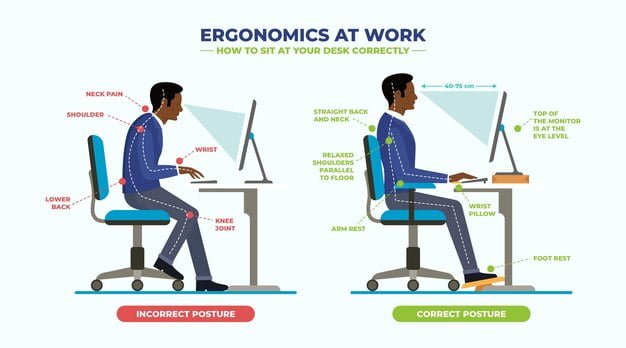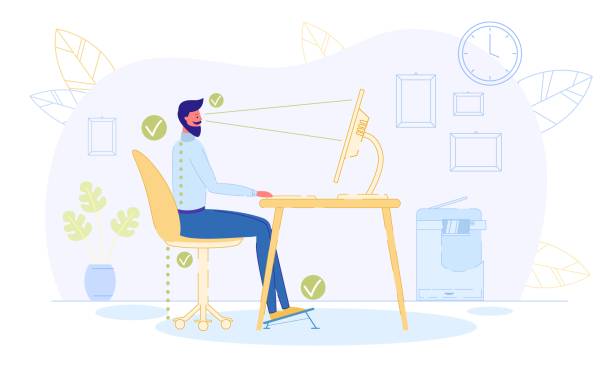
Ergonomics and Ergonomic Assessments
Ergonomics is an analysis of the interaction between the worker and the work environment. Optimizing ergonomics can increase your quality of life, improve health and safety and reduce stress and fatigue.
The International Ergonomics Association defines ergonomics as “the scientific discipline concerned with the understanding of interactions among humans and other elements of a system, and the profession that applies theory, principles, data, and methods to design in order to optimize human well-being and overall system performance. [1]“
At Vancouver based Backs in Action
our Physiotherapists, Chiropractors and Kinesiologists can all perform ergonomic assessments for your work environment or home office. These can be conducted in-person or via a Telehealth appointment so the therapist can and help you correct your workspace. Regardless of the situation you find yourself in and whether your job involves lifting, driving or sitting at your desk for most of the day, our relationship to our work environment is crucial and can mean the difference between pain and comfort.
If you think about it, most of us spend at least 1/3 of our day at work. Add our commute if we work away from home or are required to be on the road, and you can see how much poor posture, bad sitting habits or having or computer screens at the wrong height can take a toll on our bodies. For those of us who are involved with manual labour, lifting incorrectly, walking with the wrong shoes or insoles can also lead to chronic pain and long term damage to our bodies. When you compound this day after day, week after week and year after year, one can see how much stress our bodies are forced to endure.
With ergonomics, the worker should not be forced to adapt to the work environment, rather the work environment should be fitted to the worker




What Poor Sitting Posture Can Do
Sitting in the same position day-in and day-out can really take a toll on us. Here are 5 problems, amongst others, that physiotherapists, chiropractors and kinesiologists can help with.
1) The Chin Poke
When sitting in front of a laptop that is not at eye height for long periods of time, your head assumes a position known as forward head posture or FHP. To a bystander, it looks like you’re poking your forward to get a closer look at your computer screen. The chin poke puts tremendous stress on your upper back and neck leading to aching pain and tightness. As it worsens, it also causes headaches.
If you’re a sloucher, you risk acquiring kyphosis, a humpbacked position, which can result in a curvature of the upper back. In some situations, it becomes a habit that your body also takes on when standing, occurring because it requires the least amount of energy for your body to maintain. Having a hunched back leads to a number of other problems including the rounding and hiking of your shoulders, impingement, tight trapezoid muscles and the weakening of muscles that help to stabilize your shoulder blade.
2) The Upper Back Hunch
3) The Low Back Curl
Sitting for an extended period of time can cause certain muscles to tire and turn off. One muscle group that this holds true for are those that stabilize the low back. When that happens, we slouch which causes the pelvis to rotate backward in a position known as the posterior pelvic tilt. This puts our lumbar vertebrae into an awkward position in which they flex forward increasing the stress that is placed on our ligaments and joints in the lower back. This position also heightens our risk of disc herniation which in itself can lead to a whole ost of other problems.
4) The Elbow Lean
As the day progresses and we get more and more tired, we often look for something to rest our arms on from a day of bad posture. When this happens, we place our bent elbows onto our desks and lean our chins onto our bent wrists. This position puts unnecessary stress on one paricular nerve called the ulnar nerve (“the funny bone nerve” by stetching it and exposing it (i.e. the cubital tunnel) at the place where the elbow makes contact with the table. While maintaining this position for a short period doesn’t cause any problems, when doing this for longer periods of time, strange sensations, including pain, can be felt travelling down from the elbow.
5) The Bent Wrist
Bending your wrists while typing is simply an invitation for carpal tunnel syndrome (CTS). CTS occurs when your wrist is lower than your knuckles (check for this the next time you begin typing that email or document). When prolonged, space is decreased ni the already small carpal tunnel (located at your wrist). This, combined with repetitive finger movement and you have an explosive situation waiting to happen. This is because the finger muscle tendons and median nerve both travel through the carpal tunnel. Compression caused by continuously bending the wrist results in the tissues pressing and rubbing against each other more frequently further causing inflammation in the wrist. This inflammation leads to swelling which further limits the space in this tunnel. What takes the brunt of this stress is the median nerve which controls a large portion of your hand movement and sensation. This is why you will feel pins and needles along with numbness, tingling and loss of sensation in the hand with CTS. Once carpal tunnel syndrome progresses, muscle weakness will lead to a gradual loss of hand and finger function.
How A Therapist Can Help
A Physiotherapist, Chiropractor or Kinesiologist can help improve the impacts of prolonged sitting by conducting a postural adjustment, provide exercises and stretches to help you reverse the effects of poor and encroaching habits. They can provide pain-relief by conducting soft tissue work, light massage and coming up with a treatment plan to manage your pain, improve posture and help with muscle weaknesses and imbalances. They can also examine your work set-up to see how they can improve the ergonomic environment you do your work in to ensure that you can continue to work without doing harm to your body.
If you want to find out more, feel free to email us, call us at 604-876-9977 or book an appointment with a member of our team through our online booking system. If you still have questions or want to talk through what therapy or therapist might be the best fit for you, please call or email. We’re happy to help!


